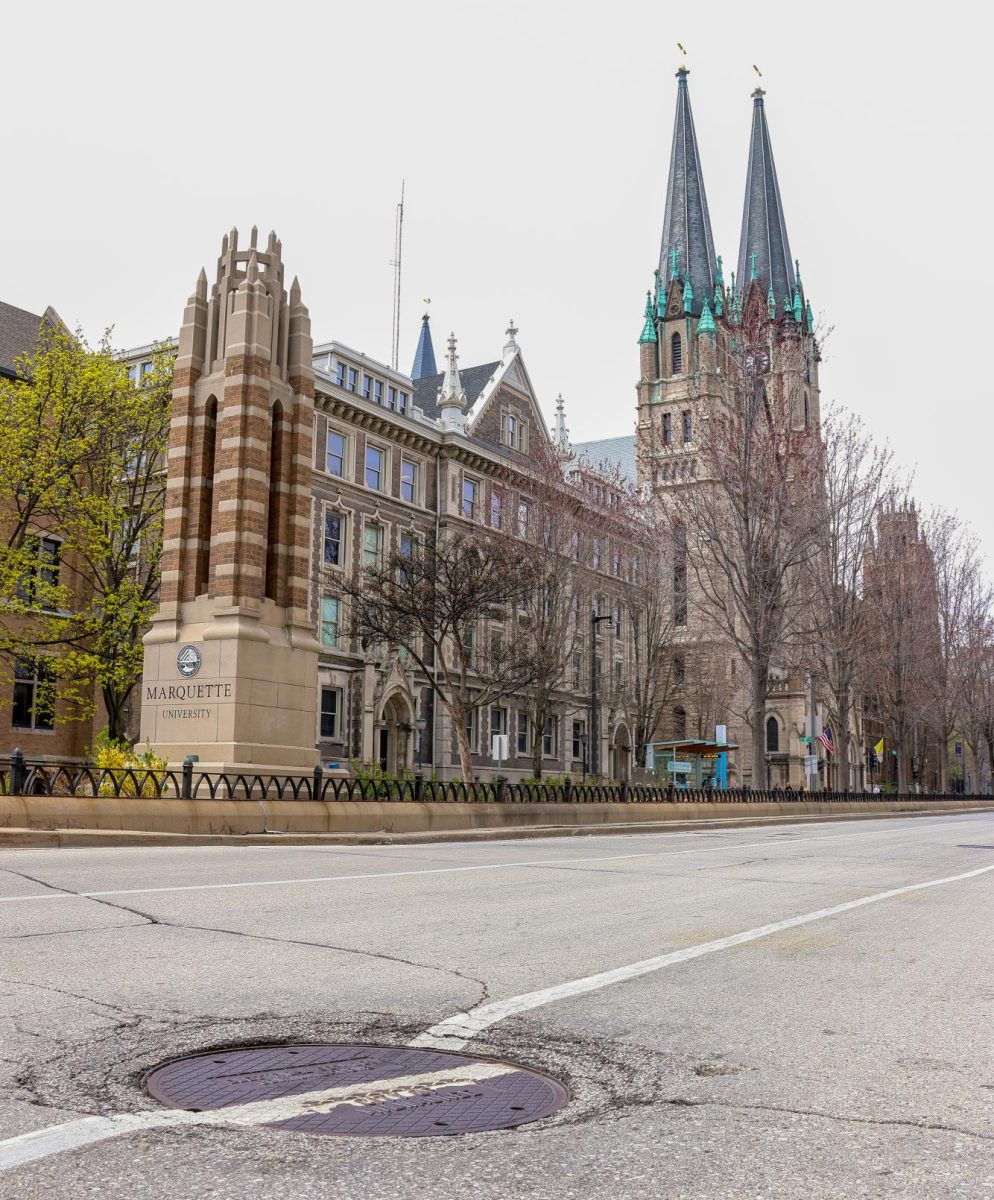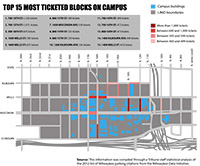For cars driving through Marquette’s campus, the continuous humming of tires rolling over the road is sometimes interrupted by the “thump” of hitting a manhole cover, briefly altering the university’s soundscape.
Those covers, though rusted over and opaque, are a window into the labyrinth of pipes and mains that run underneath Marquette and the city it calls home.
Marquette accounts for a stretch of less than 100 acres within Milwaukee. However, the sewerage system that serves it spans across approximately 430 acres of land, writing Marquette’s pipes into a larger story about sewerage management in the city.
“During normal dry weather days, the peak flow in the total area is estimated to be 26 cubic feet per second, or about 14 million gallons per day,” Tiffany Shepherd, marketing and communications officer for the City of Milwaukee Department of Public Works, said in an email. “During wet weather, the largest pipes can accommodate flow rates of up to 940 cf/s or about 500 million gallons per day.”
All of the pipes running to and through campus work with gravity to guide water underneath the city and to Jones Island, a topographical low point along Lake Michigan. The island faces the American Family Insurance Amphitheater on the Summerfest grounds from across the Kinnickinnic River, at the southern foot of the Hoan Bridge.
Inhabiting Jones Island is the Milwaukee Metropolitan Sewerage District Water Reclamation Facility, which treats the water and sewage that reaches it before putting it into Lake Michigan.
“There are a lot of mid to large-sized cities that would love to have the infrastructure that we have here,” Bill Graffin, MMSD Public Information Manager, said.
But before water reaches Jones Island, it first has to hit the ground and travel through its system of pipes, including those on Marquette’s campus.
On campus, running underneath the walkway connecting Wells Street and Wisconsin Avenue at 15th Street lies a 72-inch-wide main, lined with three layers of hand-laid brick. Aligned with 13th Street on the other side of Wisconsin Avenue, the main is a little bit smaller, measuring 64 inches wide—roughly the size of a two-seat sofa.
“There’s different sizes in different locations, depending on how MMSD set up the system at the time,” Mike Jahner, senior director of Facilities Management and university engineer, said.
Marquette’s campus operates with a combined storm and sanitary sewer system underneath, differing from other parts of Milwaukee which contain separate systems.
The original setup was established in 1870 and ushered all contents into an output point near the Menomonee River. However, the Jones Island location was introduced in the 1920s to treat water and limit pollution that reached the waterways, in conjunction with the Milwaukee Sewerage Commission. With the introduction of the new final destination, construction of combined sewers was shelved, and separate systems were built moving forward.

Though the existing combined sewers were then connected with a new output location, situations of extreme rainfall would fill the system with more water than it was built to handle, causing overflows.
The solution?
“You can think of it as a big bathtub,” Graffin said.
MMSD introduced the Deep Tunnel in 1993, a 28.5-mile reservoir that sits 300 feet under the earth. The tunnel works as a large basin to hold excess water, preventing overflows throughout the city when the sewerage system has too much water on its hands.
Once the content already within the system makes its way to Jones Island, the Deep Tunnel then empties back out into the pipes, eventually releasing its contents to be treated.
Prior to the introduction of the Deep Tunnel, the system averaged 50-60 overflows a year, equating to 8-9 billion gallons of water, according to Graffin.
Since its construction, completed over three phases, the number of overflows is down to 1-2.
Though the Deep Tunnel runs under Canal Street, on the south side of the university, Marquette has its own reservoirs for excess water—just not quite as far underground. The university’s tanks likewise prevent its systems from being forced to handle more water than they were built for, evident in recent building projects. Underneath O’Brien Hall and Engineering Hall are tanks that hold excess rainwater for safe keeping, slowly putting it back into the sewerage system once the storm begins to calm.
“It’s like a buffer tank,” Jahner said. “You take a certain amount of volume, [and] you hope that volume is enough to keep it from going to the system when the system’s taking the volume from everywhere else.”
While the ground below Marquette’s campus is a network of tanks, pipes and mains, those systems also share the space with steam tunnels and electrical systems. Each manhole cover, the rusty, opaque window into the world below, is labeled with a name, giving a glimpse into what takes place beneath it.
For water that trickles down the coats of students caught in a rainstorm and down the drains of early-morning showers, each droplet works its way through and below campus. Beneath the ground surface of students navigating college, water works its way through the city below, flowing past the manhole covers that let in glimpses of light and the occasional “thump” of a car rolling by.
This story was written by Lance Schulteis. He can be reached at lance.schulteis@marquette.edu.





